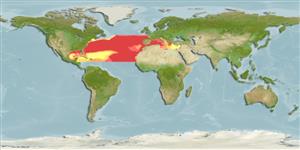>
Myctophiformes (Lanternfishes) >
Myctophidae (Lanternfishes) > Myctophinae
Eponymy: Luigi Benoit (1804–1890) was an Italian naturalist and marine biologist, ornithologist and conchologist who specialised in Sicilian fauna. [...] (Ref. 128868), visit book page.
Environment: milieu / climate zone / depth range / distribution range
Ecologia
marinhas batipelágico; oceanódromo (Ref. 51243); intervalo de profundidade 51 - 700 m (Ref. 4479). Deep-water; 48°N - 16°N
Eastern Atlantic: Portugal to the Mauritanian upwelling region including the Mediterranean. Western Atlantic: Canada to USA. Distribution may be related to the oceanographic boundaries of the North Atlantic gyral system.
Comprimento de primeira maturação / Tamanho / Peso / Idade
Maturity: Lm ?, range 3 - ? cm
Max length : 7.8 cm TL macho/indeterminado; (Ref. 128245)
High-oceanic, found below 700 m during the day and above 600 m at night (maximum abundance between 51-100 m and 301-350 m at night) (Ref. 4479). Juveniles and post-larvae are partial and non-migrants (Ref. 4479).
Ciclo de vida ou comportamento de acasalamento
Maturidade | Reprodução | Desova | Ovos | Fecundidade | Larvas
Hulley, P.A., 1990. Myctophidae. p. 398-467. In J.C. Quero, J.C. Hureau, C. Karrer, A. Post and L. Saldanha (eds.) Check-list of the fishes of the eastern tropical Atlantic (CLOFETA). JNICT, Lisbon; SEI; Paris; and UNESCO, Paris. Vol. 1. (Ref. 4479)
Status na Lista Vermelha da UICN (Ref. 130435: Version 2024-1)
Ameaça para os humanos
Harmless
Uso pelos humanos
Ferramentas
Relatórios especiais
Baixar XML
Fontes da internet
Estimates based on models
Preferred temperature (Ref.
123201): 11.5 - 18.5, mean 14 °C (based on 165 cells).
Índice de diversidade filogenética (Ref.
82804): PD
50 = 0.5020 [Uniqueness, from 0.5 = low to 2.0 = high].
Bayesian length-weight: a=0.00776 (0.00400 - 0.01507), b=3.12 (2.95 - 3.29), in cm total length, based on LWR estimates for this species & (Sub)family-body (Ref.
93245).
Nível Trófico (Ref.
69278): 3.2 ±0.3 se; based on diet studies.
Resiliência (Ref.
120179): Elevada, tempo mínimo de duplicação da população menor que 15 meses (Preliminary K or Fecundity.).
Fishing Vulnerability (Ref.
59153): Low vulnerability (10 of 100).
Nutrients (Ref.
124155): Calcium = 129 [38, 409] mg/100g; Iron = 0.672 [0.243, 2.146] mg/100g; Protein = 16.8 [14.9, 18.6] %; Omega3 = 0.516 [0.169, 1.551] g/100g; Selenium = 9.73 [2.95, 29.68] μg/100g; VitaminA = 116 [15, 964] μg/100g; Zinc = 1.04 [0.51, 2.26] mg/100g (wet weight);
